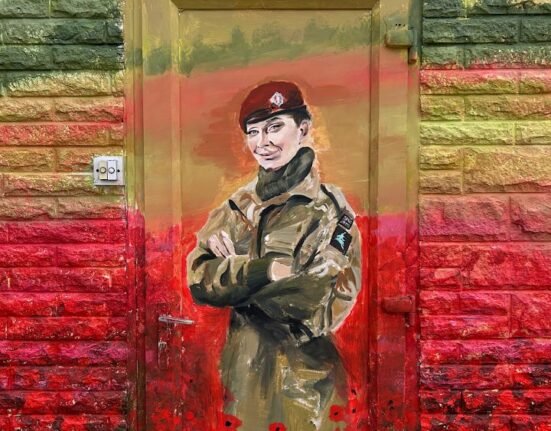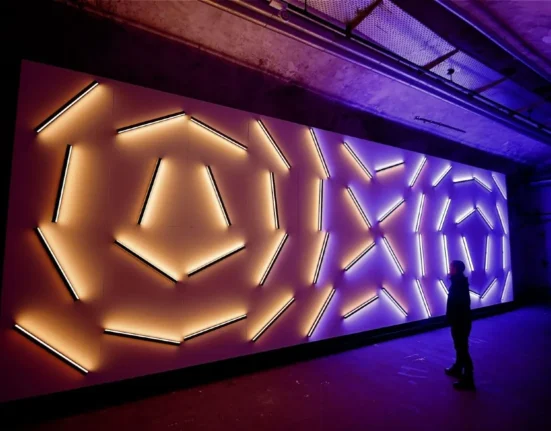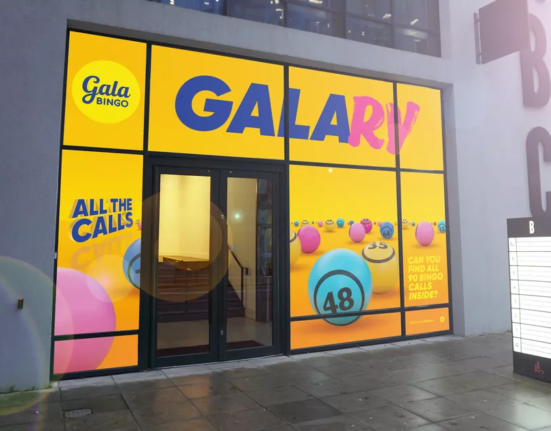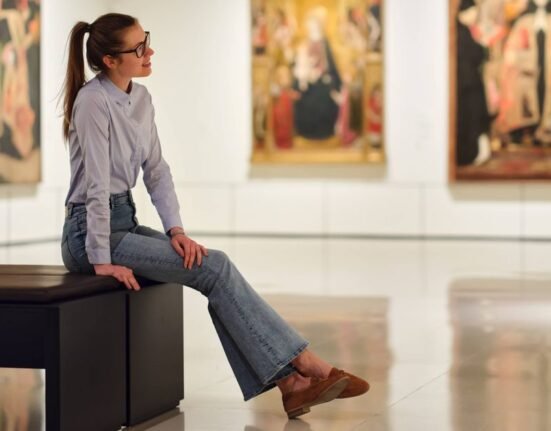
My eyes can’t stop. They’re riding high along the light gray stripe that bisects one of Mary Corse’s paintings featured in her new solo exhibition at Pace Gallery in New York, “Presence in Light.” After they reach the tippy-top point of this large, square, canted wall work, they flutter across a field of faint white strokes that initially appear as a best-in-class stippled, fine furniture finish but—with a tiny head tilt—transform into stealthy, translucent, staccato brush hits made by a seasoned artist. The work is austere, elegant and minimal. It reminds me a little of Barnett Newman’s famous vista-view, mid-century abstract “zip” paintings but contained in the pervasive American diamond shape of roadway signs intended for warning wayward drivers to pay attention. The subtle varieties of barely-there acrylic color and the thousands of light refractions from Corse’s long-favored glass microspheres—the same medium used in street markings—give me an unavoidable sense of the present moment—a distinct here in the center of now. Walking by the work and picking up poignant shifts in light makes me mindful that my perspective—as well as the particle-and-wave energy that illuminates it—is always changing.
In an interview Corse gave while her major retrospective was on exhibition at the Whitney Museum of American Art a few years ago, she made it clear that her current work was much less about the objective reality of “an outside world” than a way to provide an inner experience, through perception, for viewers. Why has the notion of perception in all its forms—or lack thereof—deeply concerned countless artists through the ages? I suspect because it can vary so greatly. This variety, of course, has caused us as many degrees of conflict as it has generated understanding, cooperation and growth. Amidst the minimal and conceptual milieu of the late 1960s, when Corse came of age as an artist, it was paramount to the investigation in many art practices—and continues to be today.
Corse, like other Californian artists associated with the Light and Space movement—from James Turrell to Helen Pashgian—made it their mission to retrain eyes, re-align minds and—I would hazard to say—open souls, even. The simple quiet moment that standing in front of one of Corse’s works engenders is a strong starting point for the activation of all those intentions. That meditative, mindful moment is one we wish we could all attend much more often—away from the cacophony of our busy working days or the common worries of our midnight hours. After looking over the artist’s work at length, I wanted to find out more.


I spoke with Corse to learn about her critical ambitions for her art—and how they relate to the viewer experience. I ask first about her show-stopping installation, The Halo Room—a large, dark, silvery cube covered in her signature luminous strokes—and Corse wants to know about my experience inside the room. While inside the installation, I tell her, a friend and I noticed something interesting: when you gaze at the emerging shadow of the other person in the room on the iridescent back white wall, you can’t see their accompanying halo—you can only see your own. “It means that art is an individual experience,” Corse told me. “My work has always been about that. It’s perceptual. What you see is different than what someone else sees.”
I can see—no pun intended—what she means. In fact, it makes me think back to my gallery experience with Corse’s Untitled (Black Diamond with Black Inner Band), 2023. The wavy deep charcoal canvas and its rich black stripe are a bit of an anomaly among the brighter and lighter paintings in the show. Like the other works on walls, however, it still beautifully bounces light as a viewer slowly moves about—yet this piece also absorbs light fast into that opaque matte black line running right down the center. As I look at the painting, a distinguished, well-dressed gentleman to my right tells his younger friend that—understandably—he thinks it’s the most meaningful, majestic piece in the show. The friend simply replies, “It doesn’t mean anything,” and hushes the gentleman, so he can have that precious quiet time, that meditative, mindful moment alluded to earlier.
Corse and I next talk a little bit about the data-dump age we’re currently living in. “I feel people are missing out on a lot today because of the problem of too much information and thinking. I don’t feel they understand how art can take you out of that thought,” Corse explains. I add that this overload from the outside world tends to short-circuit our attention spans, too. “Art is a place within you,” she answers. “It’s not about thinking. That’s what my paintings are about. It’s about your soul, your inner self. It’s not a thought.”
SEE ALSO: Gallerist Mattia De Luca Believes Morandi Has More to Teach Us
I briefly mention my own work as an artist because Corse and I share some of the same key meditative concerns. She asks me what kind of art I make. I tell her that, from years of past home renovation work, I use materials like cabinet lumber, drawer knobs, Corian, popcorn texture and fine finishes, which are assembled into symmetric wall works. I explain, “Like your art, the whole idea is to get viewers away from thinking about those materials’ original use and charged history––to get them to stop thinking altogether for a brief moment. It’s a goal of Zen meditation—along with gaining compassion and wisdom.” She agrees it’s all about the high art of thought loss: “To stop thinking and stop living life as a thought—that’s so important.”


I ask Corse how she would ideally like her work displayed, and her response comes back plainly: “Usually, there should be some natural light coming in. Ideally? A wall of my work opposite one long glass window. The work would light up entirely as you walk by at one point, although the light would change and disappear later. The paintings work with interior lighting, too. As long as they catch some light.”
They do catch light indeed in this new show—and cast it about, too. But what about those finite stripes featured in many of her works? Some bounce that light beautifully but most absorb it. When I pose this juxtaposition to her, Corse posits, “I was just thinking about those inner bands in the paintings. If you haven’t seen the metal outdoor two-sided pieces, you should. They’re made of one-inch-thick buffed mirrored steel. In those sculptures, there’s that band. The inner band is between those two flat pieces that make up the work. And before that, the inner band in the paintings appeared. Well, it appears—and disappears. It’s inside. It’s like the work was telling me, ‘Hey, it’s inside that counts.’ So, that’s what the bands represent.”
Those bands fascinate me, so, of course, I ask for their origin story. And I am not disappointed. “The first time, in ‘65, a diamond painting I worked on was accidentally indented,” Corse begins. “It was all white except for about half an inch that was creased near the center along the whole thing––and it didn’t get as much paint. I liked that!” I suggest it’s almost like the indentation signified a protected, personal, inner place that doesn’t get hit as much with the onslaught of information, complex relationships and our dreaded thoughts. “Certainly! My work is about that inner band,” exclaims Corse.
I find this interesting. It’s almost like the band is a joining point. In some cases, I feel like it’s a rest, a reprieve. In other cases—like the “jewel”-encrusted inner bands in some of Corse’s paintings—it’s similar to a bridge where the force of tectonic plates somehow culminates into a solid geological formation. Of course, that’s just my perception and interpretive thinking. If I just take a moment and stop thinking, the mystery and impact of those bands—and her paintings—swells up a little more powerfully. Is the quality of my perception better with less thought? Not exactly, but it’s different and necessary—and isn’t exercised nearly enough in my life, as I’m sure is true for the lives of many.
After our conversation, I looked over the images that I took of Corse’s work at “Presence in Light.” I then go to see the show again in person.
Back at Pace, I’m drawn to the far corner of the room. A gorgeous glistening piece, which has stayed with me since I first saw the show, Untitled (Yellow Diamond with White Inner Band), is extraordinary. The low-luster sheen it gives off—like the other paintings—ripples and winks at me as I cross paths with it. It really is, in a sense, talking with me or “telling” me something, as Mary suggested. There’s a communication of energy. Not numbers, not information and most definitely not thought. As I come around to the front of it, the golden, sunny, calming color almost simmers—but never quite settles. That stripe or “inner band” strikes a balance between the two activated halves of the painting.
As I walk towards its center, my fuzzy gray shadow and outer glow begin to emerge up through the diamond’s lower point. Like the silhouette created in The Halo Room on the wall, I—the observer—am emerging into the work. The light that strikes my likeness into the canvas is also igniting the gold on the surface. But the inner band—that protected interior place—remains untouched. Its matte finish even blends at the edges into the white wall where it hangs, blurring object and background and me—the viewer—all at once. Right there, on the spot, I lose my thoughts again as an ensuing peace sets in.
And with that, Mary Corse gets her wish.
“Mary Corse: Presence in Light” at Pace Gallery closes on October 26.







